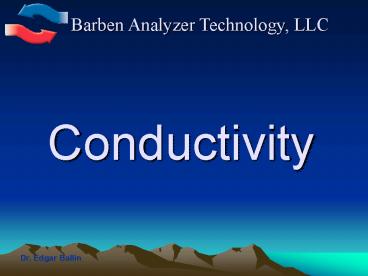Conductivity - PowerPoint PPT Presentation
1 / 22
Title:
Conductivity
Description:
calculate pH-value via differential technique (high purity) ... galvanic 'conductive ') principle. inductive principle. I. U. e.g. 100 Ohm. I. sender. receiver ... – PowerPoint PPT presentation
Number of Views:365
Avg rating:3.0/5.0
Title: Conductivity
1
Conductivity
Dr. Edgar Ballin
2
Conductivity Measurement Principle
Goal of Conductivity Measurement
- monitor conductivity- hi-purity for boiler feed
water,- break through detection heat
exchangers membranes- pharmaceutical water USP
- calculate conductivity for a given temperature
- determine concentration
- determine salinity
- calculate membrane efficiency
- calculate pH-value via differential technique
(high purity)
3
Conductivity Measurement Principle
1 Resistivity Conductivity
1 Conductivity Resistivity
4
Conductivity Measurement Principle
Conductivity 1 1 Siemens 1 Mho
OM OM 1 Ohm X 1 Meter
5
Conductivity Measurement Principle
inductive principle
e.g. 100 Ohm
6
Conductivity Measurement Principle
Conductivity (?) Conductance (G) X Cell
Constant (c)
A
Cell Constant c c Length / Area
7
Conductivity Measurement Principle
Conductivity (?) Conductance (G) X Cell
Constant (c)
1 cm (length) 1 cm2 (area) 1 Cell Constant
0.1 cm (length) 1 cm2 (area) 0.1 Cell
Constant
Cell Constant c c Length / Area
The bottom line High Conductivity requires High
Cell Constant Low Conductivity requires Low Cell
Constant
Cell Constant c c Length / Area
8
Conductivity Measurement Principle
Cell constant Optimum Conductivity Range
(µS/cm) 0.1 0.5 to 400 1.0 10 to
2000 10.0 1000 to 200,000
9
Conductivity Measurement Principle, 2 Electrode
10
Conductivity Measurement Principle, 2 Electrode
electrical potential
Help alternating anode /cathode
11
Conductivity Measurement Principle
SensoCheckâ
polarization
u
meas.
0
t
-u
12
Conductivity Measurement Principle 4 Electrode
polarization
polarization effects are eliminated by separating
current and voltage path
voltage path
13
Conductivity Measurement Principle Inductive
(Toroidal)
inductive principle
e.g. 100 Ohm
14
Conductivity Measurement Electrodes
Conductivity probes
GSX
15
Conductivity Measurement Installation
Requirements
C a l i b r a t i o n r e q u i r e d
metal
correct
too low
too high
16
Conductivity for Determination of Concentrations
Determination of concentration via
conductivityis possible for pure aqueous
solutions of
- NaCl (Salt)
- HCl (Hydrochloric Acid)
- NaOH (Sodium Hydroxide Caustic)
- H2SO4 (Sulfuric Acid)
- HNO3 (Nitric Acid)
17
Conductivity for Determination of Concentrations
18
Conductivity for Determination of Concentrations
Isotherms of Conductivity over concentration
(here Sulfuric Acid)
19
Conductivity Temperature Compensation
Temperature compensation for conductivity
measurement Advantage- comparable
values Problem- very important reason for
wrong determination - temperature coefficient is
mostly unknown - the conductivity is very often a
non-linear function of the temperature -
dependance of the temperature function on the
concentration itself
20
Conductivity Temperature Compensation
21
Conductivity Temperature Compensation
Further non - linear functions for Conductivity
22
Protos Special Feature
Calculation of pH based on conductivity
measurement
conductivitymeasurement I
conductivitymeasurement II
ion exchanger
23
Protos Special Feature
Calculation of pH based on the conductivity
measurement































